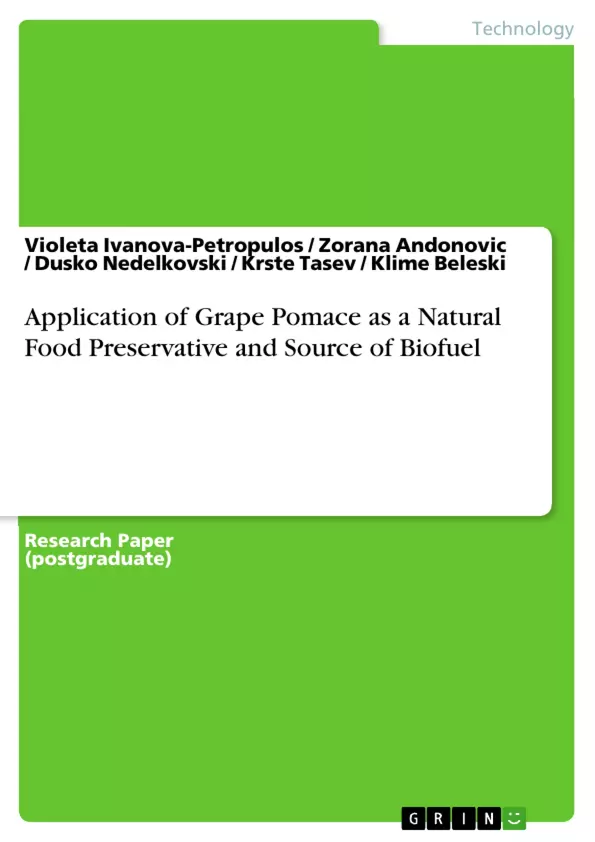The purpose of this study was to introduce a new source of antioxidants obtained from grape pomace as well as aronia and blueberry and engages them in preparation of a new yoghurt product in order to be last – longer and more beneficial for human health than the traditional one. Totally, grape pomaces from 4 varieties (Zupjanka, Prokupec, Kadinal and Vranec), as well as blueberry and aronia, were used. For the extraction of polyphenolics, liquid-liquid extraction with ethanol/water/acetic acid was used, followed by roto-evaporation, in order to concentrate the extracts and then to introduce them into the milk. The total phenolic content of the extracts was determined by the Folin-Ciocalteu method and the total anthocyanins were analyzed by dilution of the samples with ethanol/water/HCl, obtaining three different volumes of extracts (10, 50 and 100 mL) of each sample (grape pomaces, blueberry and aronia), obtaining 36 extracts in total. The three different concentrates of each sample (18 in total) were applied on milk together with the lactic bacteria in order to study the influence of polyphenolics during the fermentation; as well as, 18 other extracts applied on milk after the fermentation (into the obtained yoghurt). The pH value of the newly generated yoghurts was analyzed during the fermentation and storage.
The aronia sample presented highest phenolic content (431 mg/L), while Zupjanka had the lowest content of polyphenols (67.9 mg/L). The grape pomace presenting best results was Prokupec (246 mg/L). All yoghurt samples containing polyphenolics applied before the fermentation, presented higher pH value compared to the control and samples with polyphenolics applied after fermentation. Furthermore, all yoghurt samples containing phenolics extract with highest concentration, showed best results, presenting stable pH value. Sensory analysis was performed on the different yoghurt samples, concluding that the new products have creamy texture, good taste, without unpleasant smell or bitterness. The colour of some samples turned into red-violet, excluding the yoghurt with extracts from: Zupjanka and Kardinal. By microbiological analysis the presence of pathogen and other harmful bacterias was proved to be negative, showing that this yoghurt is a main basis for manufacturing of a more beneficial dairy product that could be soon available on the market.
Inhaltsverzeichnis (Table of Contents)
- INTRODUCTION
- 1.1 Grape pomace
- 1.2 Polyphenols
- 1.3 Yoghurt
- 1.4 Biofuel
- EXPERIMENTAL (PART I)
- 2.1 Samples
- 2.2 Extraction of phenolic compounds from samples
- 2.3 Determination of total polyphenols
- 2.4 Determination of total anthocyanins
- 2.5 Concentration of extracts with rotoevaporation
- 2.6 Application of phenolic dry extracts in milk during fermentation
- 2.7 Application of phenolic dry extracts after fermentation i.e. in yoghurt
- 2.8 pH Measurement of the new yoghurt
- RESULTS (PART I)
- 3.1 Spectrophotometric analysis
- 3.2 pH variation of the obtained yoghurt
- 3.3 Sensory analysis of the new product
- 3.4 Microbiological analysis of the new yoghurt products
- EXPERIMENTAL (PART II)
- 4.1. Production of biodiesel from grape winery waste and fruit peels
- RESULTS (PART II)
- DISCUSSION
Zielsetzung und Themenschwerpunkte (Objectives and Key Themes)
This study aims to explore the potential of grape pomace, a byproduct of winemaking, as a source of both natural food preservatives and biofuel. The research focuses on the extraction of polyphenolics from grape pomace and their application in developing a novel, antioxidant-enriched yoghurt product. Additionally, the study investigates the production of biodiesel from grape pomace seeds and fruit peels.
- Utilization of grape pomace as a sustainable resource
- Extraction and application of polyphenols for food preservation and enhancement
- Development of an antioxidant-rich yoghurt product with improved nutritional value
- Production of biodiesel from grape pomace seeds and fruit peels
- Exploration of alternative energy sources and environmental sustainability
Zusammenfassung der Kapitel (Chapter Summaries)
The introduction provides a comprehensive background on grape pomace, polyphenols, yoghurt, and biofuel, outlining their relevance to the study.
The first part of the experimental section delves into the detailed procedures for collecting and preparing samples, extracting polyphenolics, and determining their content. It also describes the methods used for concentrating the extracts and applying them to milk during fermentation. The final section of this part outlines the procedure for applying the extracts after fermentation, as well as the methods for measuring the pH of the newly produced yoghurt.
The first part of the results section presents the spectrophotometric analysis findings, focusing on the polyphenol content of various grape pomace samples. It also highlights the impact of polyphenolics on the pH variation of the new yoghurt product. The sensory and microbiological analysis of the yoghurt is presented as well.
The second part of the experimental section describes the process of producing biodiesel from grape winery waste and fruit peels. The results of the biodiesel production, including the extraction yield and characteristics, are presented in the subsequent chapter.
Schlüsselwörter (Keywords)
Grape pomace, polyphenols, antioxidants, yoghurt, biodiesel, food preservation, nutritional value, sustainable resource, energy crisis, environmental sustainability.
- Arbeit zitieren
- Violeta Ivanova-Petropulos (Autor:in), Zorana Andonovic (Autor:in), Dusko Nedelkovski (Autor:in), Krste Tasev (Autor:in), Klime Beleski (Autor:in), 2014, Application of Grape Pomace as a Natural Food Preservative and Source of Biofuel, München, GRIN Verlag, https://www.hausarbeiten.de/document/276447


